A team of investigators led by archaeologist Ken Wild has been conducting a study of a historic shipwreck in Coral Bay Harbor since February.

They are conducting excavations and mapping the remains of a ship, officially known as Coral Bay Shipwreck 1, which has been partially submerged in mud for as many as 300 years.
The ship, around 65 feet in length, is typical of sailing vessels of the early 18th century, according to Wild, but it’s still unknown what flag it might have sailed under or what its primary purpose might have been. “Did it belong to a planter, a trader, a smuggler, a military unit? There seem to be gun barrels, but any ship would have to be armed because of the danger of piracy,” Wild said.
Wild is hoping that artifacts they find, such as ceramics and bottles, will narrow down the date of the ship’s activity, and wood samples might indicate where the ship was built. One of the main objectives of the testing is to determine the integrity of the ship. The fact that it is buried in thick mud raises the possibility that organic remains — such as cloth, rope, and plant remains — could be preserved.
If so, Wild said the wreck would be extremely important as it could answer many research questions about the history of the Virgin Islands during this era. He’s looking forward to the subsurface testing in the coming weeks. So far, earlier investigations have revealed clay pipe stems commonly used by Dutch planters, a small cross of pewter or silver, and bottles that were in use in the 1730s or 1740s.

These artifacts suggest the boat was Dutch and was plying the seas around the time of the Slave Insurrection in 1733 on St. John, but at this point, it’s impossible to know.
“The Virgin Islands comprise approximately 90 islands, islets, and cays, all within a day’s sail of one another and visible from Puerto Rico, “ Wild wrote in his study proposal. “Proximity to Spain’s prosperous Puerto Rican port rendered these small islands, with their excellent anchorages and surrounded by high hills such as Coral Bay, ideal rendezvous and hideouts for Dutch interlopers, Queen Elizabeth’s Sea Dogs, and French Huguenots.”

Wild is working with a select team of volunteer divers to map out a grid for further exploration of the wreck. They will use a dredge to suck up the mud and carefully screen it for artifacts and other clues that might tell the ship’s story in more detail. Anything of significance they find will be replaced after the investigation has been completed. Then the site will be covered by a protective mat.

Their work isn’t easy. The ship is submerged under about 18 feet of water. On a really good day, visibility is around 10 feet. On most days, it’s more like two. “You kind of do it by braille,” joked lead diver Colin Hanson. “You can usually see the ballast pile, and sometimes you can see the ribs and timbers.”
The investigative study is being financed by private donors and funding from the St. John Historical Society, and donations are being gratefully accepted.
The project is being conducted under the auspices of the Virgin Islands State Historic Preservation Office, headed up by Sean Krigger.
“My hope is that Ken will be able to verify the age of the ship. Thus far, he thinks it’s a Dutch ship from the 1700s, a very interesting part of our history,” said Krigger.
Wild has said ships of this size were oceangoing and were used in the Slave Trade.
Until last year, the shipwreck was located directly below a section of a planned marina. The Yacht Club Summer’s End, also known as the St. John Marina, has been planned since 2014 but has not yet received all its permits. As more data confirmed the wreck’s historical significance, the marina designers cut back on the docks’ footprint.
Krigger said he hoped that this study will better define the site. “We have been working with the developers of the Summer’s End Group. They have committed to protecting this resource and made changes to their marina design. The better we can define the limits of the site, the better we can protect it.”
More than 30 years ago, mariners in Coral Bay discovered portions of Coral Bay Shipwreck 1 in the middle of the mooring field. Wild completed the first archaeological report on the shipwreck for the Virgin Islands government, identifying it as an early 18th-century wreck several years ago.
Since then, a number of researchers have visited the site, including a team of investigators that arrived on island to conduct an additional survey. Fearing that news of the discovery would lead to the desecration of the site, the information was kept quiet until 2021.
Krigger said the Historic Preservation Office usually does not publish the location of shipwrecks to protect them from being plundered by modern-day treasure hunters. “We have resources to enjoy but not for individuals to profit from,” he said. Recently, however, they decided to mark the location of the wreck of the Santa Monica in Round Bay to keep boaters from damaging it when they drop their anchors.
This phase of the investigation of Coral Bay Shipwreck 1 is expected to be completed by the end of April. Members of the public who wish to donate or assist in other ways should contact Ken Wild at 904-583-4721.


